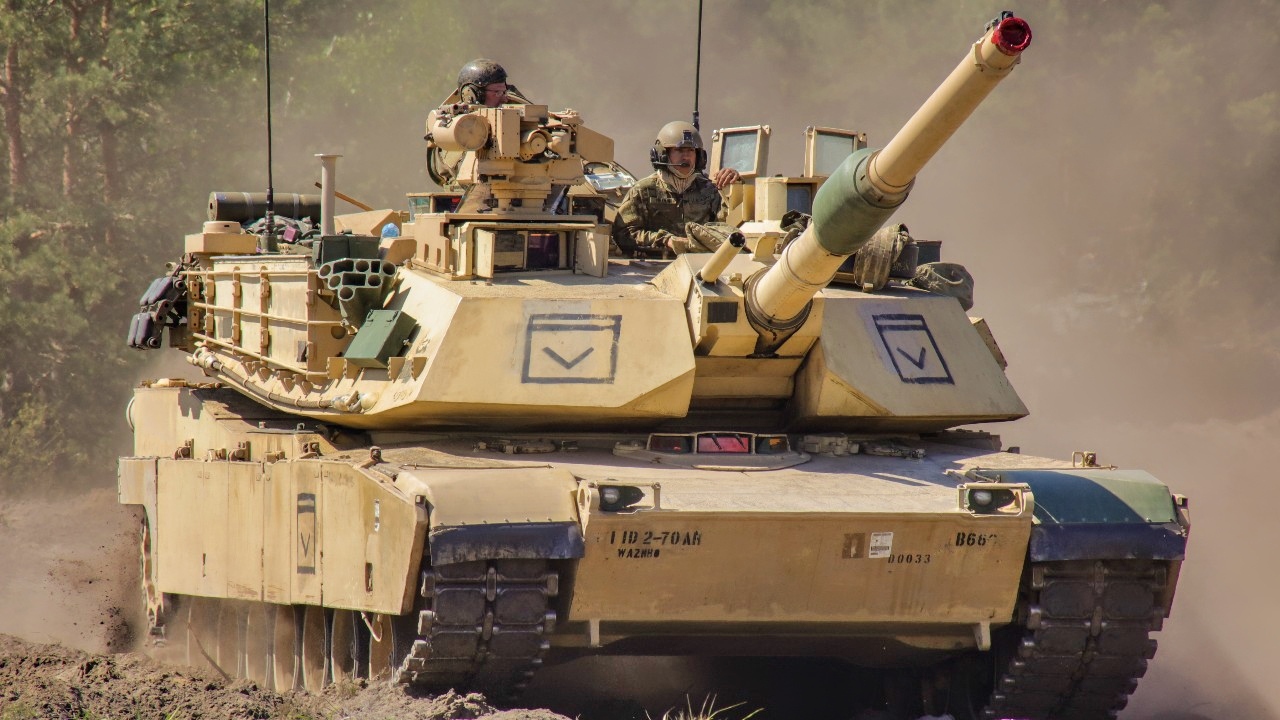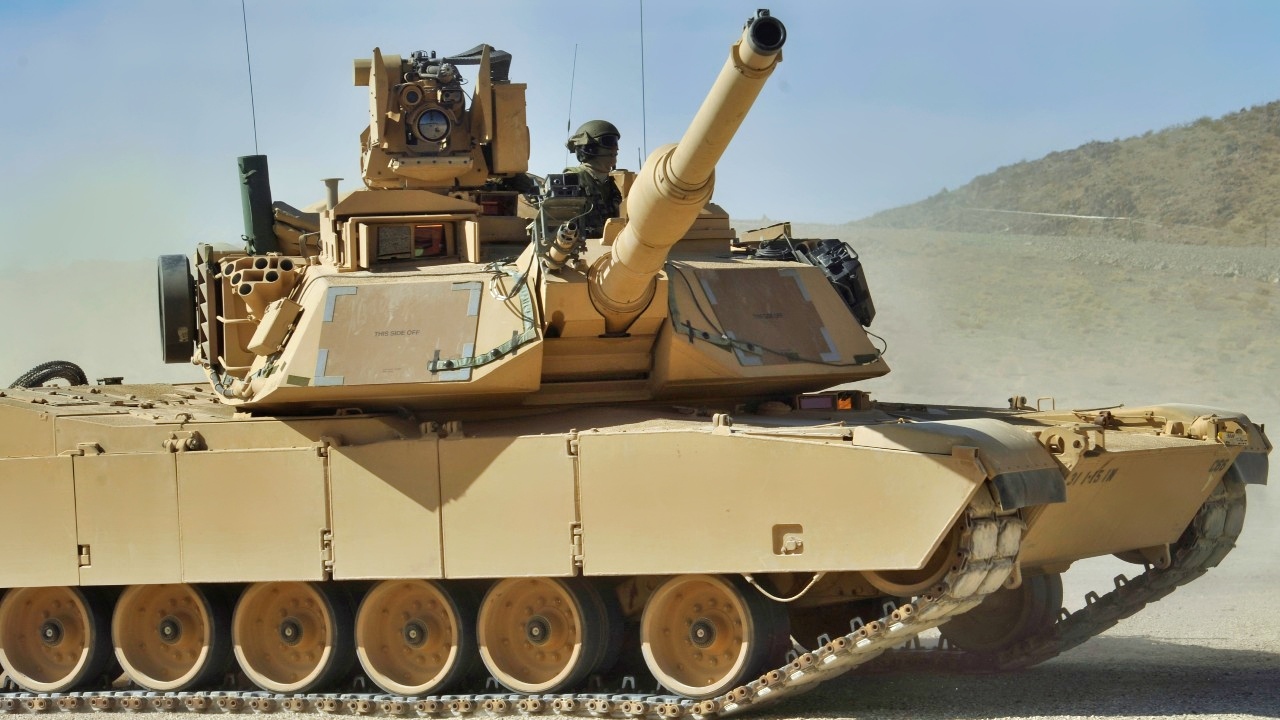Key Points and Summary – America’s M1E3 Abrams and Russia’s T-14 Armata aim to redefine the main battle tank for the drone-saturated battlefield.
-The M1E3 sheds weight, adds a hybrid powerplant, integrated APS, modular armor, and likely an autoloader—pushing mobility and sustainment while hardening against ATGMs and loitering munitions.

CINCU, Romania – U.S. Army Soldiers of 1st Battalion, 66th Armored Regiment, 3rd Armored Brigade Combat Team, 4th Infantry Division, setup their M1 Abram Tanks during Getica Saber 17, July 10, 2017. Getica Saber 17 is a U.S.-led fire support coordination exercise and combined arms live fire exercise that incorporates six allied and partner nations with more than 4,000 Soldiers. Getica Saber 17 runs concurrent with Saber Guardian 17, a U.S. Army Europe-led, multinational exercise that spans across Bulgaria, Hungary and Romania with more than 25,000 service members from 22 allied and partner nations. Image Credit: US Military.

A U.S. Army M1 Abrams, assigned to 4th Battalion, 6th Infantry Regiment, 3rd Armored Brigade Combat Team, 1st Armored Division, fully emerges from the tank firing point to engage the simulated enemy at Novo Selo Training Area, Bulgaria, March 5, 2025. 1st Armored Division, a rotational force supporting V Corps, conducts training with engineers and tank operators in the European Theatre to maintain readiness and instill fundamental Soldier skills that are vital in maintaining lethality. (U.S. Army photo by Spc. Kyle Kimble)
-The T-14 counters with a fully unmanned turret, a protected three-man crew capsule, Afghanit APS, modern ERA, and a powerful 125mm gun with missile options.
-Sensors, AI-assisted fire control, and automation feature on both. On paper, detection and first-shot advantage decide a duel.
-In practice, production scale, reliability, and integration may be the real tiebreakers.
M1E3 vs. T-14 Armata: Who Wins?
The T-14 receives significant criticism from Western analysts for its slow rate of production and other development issues.
However, the tank introduced several design features that influenced subsequent tank designers, such as the unmanned turret and a protected crew capsule.
On the other hand, the M1E3 is the next iteration of the M1 Abrams. The tank is expected to incorporate several new features, including an autoloader, state-of-the-art electronics, a new hybrid powerplant, and much more.
Both the M1E3 and the T-14 are envisioned as next-generation tanks, but which is superior?
The M1E3 vs the Armata
The M1E3 is designed to address the limitations of its predecessors, particularly the M1A2 SEPv3 and SEPv4.
It incorporates lessons learned from recent conflicts, including the war in Ukraine, where Western tanks faced threats from drones, loitering munitions, and advanced anti-tank weapons. One of the most significant changes in the M1E3 is its weight reduction.

T-14 Armata. Image Credit: Creative Commons.

Main battle tank T-14 object 148 on heavy unified tracked platform Armata. Image Credit: Creative Commons.
While the SEPv3 weighed nearly 80 tons, the M1E3 aims to come in closer to 60 tons, improving mobility and easing its logistical burden.
This is achieved through a redesigned hull and turret, likely incorporating lighter composite materials and a more efficient layout.
The T-14 Armata’s design, meanwhile, is a significant departure from its Soviet predecessors. It is built on the Armata Universal Combat Platform, which is intended to serve as the basis for a new family of armored vehicles.
The tank features a fully unmanned turret, a first for a production MBT, and places its three-man crew in an armored capsule within the hull.
This design significantly enhances crew survivability by isolating the crew from ammunition and other vulnerable components.
The Armata is powered by a 1,500-horsepower diesel engine, giving it a high power-to-weight ratio and a top speed of around 80 to 90 kilometers per hour, making it one of the fastest tanks in the world.
Firepower
In terms of firepower, the M1E3 is expected to retain a 120mm smoothbore gun, possibly the XM360, which is lighter and more efficient than previous models. This gun will likely support a range of advanced munitions, including programmable airburst rounds, gun-launched anti-tank guided missiles (ATGMs), and, according to some reports, hypersonic projectiles in the future.
However, it is unclear what this entails.

U.S. Soldiers assigned to 2nd Battalion, 70th Armor Regiment, 2nd Armored Brigade Combat Team, 1st Infantry Division supporting the 4th Infantry Division, maneuver an M1A2 Abrams tank while participating in a combined arms rehearsal during Anakonda23 at Nowa Deba, Poland, May 14, 2023. Anakonda23 is Poland’s premier national exercise that strives to train, integrate and maintain tactical readiness and increase interoperability in a joint multinational environment, complimenting the 4th Inf. Div.’s mission in Europe, which is to participate in multinational training and exercises across the continent while collaborating with NATO allies and regional security partners to provide combat-credible forces to V Corps, America’s Forward deployed corps in Europe. (U.S. Army National Guard photo by Sgt. 1st Class Theresa Gualdarama)
The inclusion of an autoloader not only increases the rate of fire but also reduces crew fatigue and allows for a smaller crew size.
The T-14 Armata is equipped with the 125mm 2A82-1M smoothbore cannon, which is more powerful than the older 2A46 used in previous Russian tanks. It can fire a variety of munitions, including the 9M119 Refleks ATGM and the newer 3UBK21 Sprinter missile, which has a range exceeding seven kilometers.
There have been discussions about upgrading the Armata to a 152mm gun, which would give it unmatched firepower, but this has not been implemented in production models. Like the M1E3, the T-14 also uses an autoloader, allowing for a three-man crew and a compact turret design.
Protection and Survivability
In terms of protection, both tanks possess state-of-the-art protection systems. The M1E3 integrates an Active Protection System (APS) directly into its architecture, rather than relying on bolt-on solutions like earlier Abrams variants.
This APS is likely a variant of the Israeli Trophy or Iron Fist systems, capable of intercepting incoming projectiles such as RPGs and ATGMs.
The tank also features modular armor, which allows for easier upgrades and repairs, and includes counter-drone systems to address the growing threat of unmanned aerial vehicles on the battlefield.
The T-14 Armata uses the Afghanit APS, which includes radar-guided interceptors and electronic warfare capabilities.
Not much information is available about the Afghanit systems, but it is reportedly similar to the Trophy systems and can intercept armor-piercing projectiles and ATGMs, though this has yet to be demonstrated.
Its armor consists of composite materials and the Malachit explosive reactive armor (ERA), a fourth-generation system.
Mobility and Electronics
The M1E3 is expected to feature a hybrid-electric drivetrain, which reduces fuel consumption, lowers its thermal and acoustic signature, and improves stealth. This system also contributes to the tank’s weight reduction and enhances its operational range. The T-14 is equipped with a 12N360 Twin Turbo Diesel engine and hydropneumatic suspension, offering excellent speed and maneuverability, particularly in open terrain. Its adjustable ground clearance allows it to adapt to a range of environments, from urban combat to rough terrain.
Automation is a central feature of both platforms. The M1E3 reduces its crew size to three by incorporating an autoloader and may feature an unmanned turret, although this has not been confirmed.
Its AI-assisted targeting systems help identify and prioritize threats, improving reaction times and reducing human error. The T-14’s crew capsule is a standout feature, offering unparalleled protection. Its unmanned turret and advanced sensors provide 360-degree surveillance and real-time data sharing, making it one of the most digitally integrated tanks in existence.
Which Tank is Better? Summed Up in 2 Words: Shoot First?
When comparing the two tanks, there isn’t exactly a clear winner. Assuming we take everything we know about these tanks at face value, both platforms are evenly matched.
Both possess the firepower, armor, and electronics required to win a 1v1 against any tank in the world. But what would happen in a one-on-one fight?
Assuming the battle takes place in an open field, both tanks would likely detect each other simultaneously thanks to their advanced sensors. From then on, the winner depends on who can fire off the first shot.
About the Author: Isaac Seitz
Isaac Seitz, a Defense Columnist, graduated from Patrick Henry College’s Strategic Intelligence and National Security program. He has also studied Russian at Middlebury Language Schools and has worked as an intelligence Analyst in the private sector.
More Military
The British Army’s Big Challenger 3 Tank Mistake Still Stings
F-35 Stealth Fighter Program Has Passed the Point of No Return
The Iowa-Class Battleships Have A Message for Any Navy on Earth
Canada Has a Big Message for the Eurofighter Typhoon
The Mach 2 F-16 Fighting Falcon Fighter Has a Message for the U.S. Air Force










